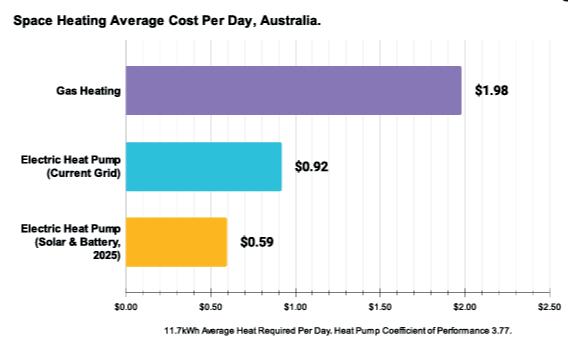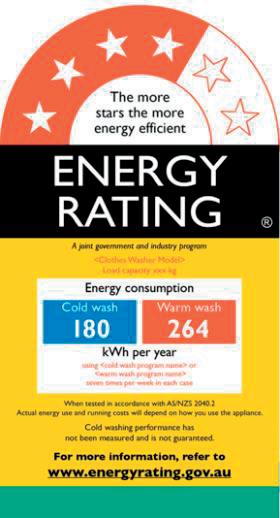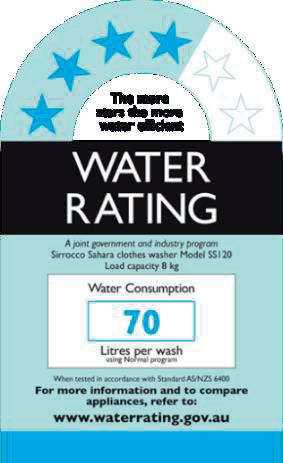
3 minute read
CARBON ZER TATURA
How well do your appliances rate?
Yvonne O’Connell (GV Community Energy)
Advertisement
In this last article in this series, we investigate how well our appliances at home perform in regard to energy use.
All new household appliances come with an energy star rating. The energy rating label will tell you the efficiency of the appliance when compared with other appliances of the same type and size. On most appliances the label shows a star rating from 1 to 6 stars: the more stars, the more efficient the product. Some products may exceed 6 stars - these will be shown with a modified label.
The energy rating label also shows the estimated annual electricity usage in kWh. It is essential to consider this figure when comparing products, because a large model with the same star rating as a smaller model will use more electricity!

When considering purchasing appliances, many people compare star ratings of new products against the faded label still on their existing one - this will be misleading as rating scales today are stricter than yesteryear as they are adjusted to accommodate improved energy efficiency. The energy consumption number (kWh) on the label is the most reliable basis for comparing old and new appliances.

Similarly, the Water Efficiency Labelling and Standards (WELS) scheme is a mandatory national labelling scheme for some whitegoods and plumbing products. The water rating label has 1 to 6 stars, and more stars indicates better water efficiency.

These labels show the star rating and average water use per wash for dishwashers and clothes washers. Total water consumption per wash cycle under test conditions is the key figure to use when comparing different models. Labels for plumbing products such as tapware and showerheads also show flow rates. In a country like ours with scares water resources it makes sense to minimise our water consumption!
Air conditioning is typically the largest energy user in our homes. We use this term here to describe both heating and cooling needs. Airconditioning can account for up to 50% of the annual energy used in a typical Australian household.
Most older homes were built to use separate appliances for heating and cooling Traditionally electricity, wood, or natural gas were used for heating. Many homes then had a separate evaporative cooler or refrigerated air conditioner added over time. Evaporative coolers are very energy efficient as they only need run a fan when operating unless the water is supplied by a pump and then this pump will run sporadically throughout the operation of the cooler.
Nowadays reverse cycle air conditioners (heat pumps) are the most efficient appliances to both heat and cool a home. They are often installed as either a wall or ceiling mounted split system, or a centrally ducted system. This technology extracts heat from ambient air and uses a refrigerant to transfer heat into the home in winter or transfer it outside the home in summer. They can operate with efficiencies of up to 5 which means that the heating output is up to 5 times as great as the power required, making them very economical to run.
Always check the star rating system before purchasing an air-conditioner to help you select the most efficient one.
The figure below compares the daily heating costs for different heating systems applying to an average household in a climate like Tatura
Water heating is the second largest source of energy expenditure in Australian households, making up 25% of the average energy use. Approximately 45% of all water heaters in Australia are gas, 45% are electric, and the remaining 10% are a solar collector with gas or electric boosters or heat pumps.
Heat Pumps

Much like air-conditioning, heat pump technology offers now the most energy efficient way to heat your water with heating output efficiencies up to 6 times as great as the power required. The cost of water heating by heat pump is approximately half compared to heating by natural gas. When purchasing a heat pump, check its Coefficient of Performance rating (COP). This is often combined with use of CO2 gas as the refrigerant which has a lower “Greenhouse gas potential” so if any gas is accidentally released, it is less toxic to the atmosphere.
Solar Water Heaters
Solar water heaters have comparably low running costs compared to other domestic hot water systems, but they are often more expensive to purchase and install and require either an electric or gas-boosted backup system to help heat the water in winter, and these are less efficient than a heat pump option. A luxurious shower of say, 8 minutes duration, will have a wide range of costs depending on heating source.










